Esthetic Transitional Temporaries: The Key to Esthetic Success
Wynn H. Okuda, DMD
Creating predictable results with cosmetic dentistry is certainly the ultimate goal that every practitioner wants to achieve. However, achieving this result and patient satisfaction can be challenging at times. Because cosmetic dentistry is artistic in nature, there is much subjectivity in fabricating the final esthetic results. What the clinician may consider as esthetic may not coincide with what the patient views as esthetic.
In providing indirect cosmetic dental restorations there is much to consider before delivering the final product to the patient. To achieve consistent success with each cosmetic dental patient, it is important that the dentist have tools that will help remove the subjective nature of esthetics. One of these tools for success is the use of esthetic transitional temporary restorations.
Clinical Approach to Esthetics
There are many elements to consider in properly delivering cosmetic dentistry. From the diagnostic phase, to the fabrication of the cosmetic restorations, and to the final adhesion of the restorations, there are many details in restoring teeth esthetically (Figure 1).1,2 Although each step is important, the esthetic transitional phase is one step that is essential in creating predictable esthetic results (Figure 2 and Figure 3). The Esthetic Transitional Temporaries (Brasseler USA, Inc, Savannah, GA) give the patient a great preview of the actual sizes, shapes, and color of the new smile. By removing the subjectivity of esthetics, this phase allows each esthetic case to “transition” in the most predictable way possible.
Interestingly, this step is one of the most underused procedures in cosmetic dental treatment. Many times the temporization phase is considered a chore to most dentists and therefore delegated to dental auxiliaries. Dental auxiliaries who are properly trained to sculpt esthetic transitional restorations may be able to attain the results needed. However, those not knowing the details needed to perform this procedure may create temporaries that are not optimal for cosmetic dentistry. Without proper consideration of this phase, achieving the best possible esthetics is like trying to shoot a target in the dark.
Esthetic Protocol
In creating esthetic transitional restorations, the practitioner must take the time to first study the esthetic needs of the patient. A proper esthetic diagnosis along with diagnostic records should be taken before starting any cosmetic case (Figure 4). Facebow-mounted diagnostic models, diagnostic dental photographs, and proper bite records, etc, are needed before starting the cosmetic dental evaluation. A comprehensive study of the patient’s face and smile is also completed at this time so that optimal facial esthetics can be achieved.3-5
Material Selection
For many years, the powder/liquid acrylics have been the mainstay for custom provisionalization. Although acrylic resins made an acceptable short-term restoration, there were many inadequate aspects to these materials. The considerable amount of material shrinkage along with color instability and a strong, unpleasant odor of acrylic left a lot of room for improvement. With the emergence of the resin-based provisional materials, a new level of temporization was achieved. This resin-based material provides a color-stable, odorless provisional restoration with very low shrinkage. With tremendous improvement in the latest bis-acryl, resin-based temporization materials (eg, Luxatemp® Fluorescence, Luxatemp® Plus, Zenith/DMG, Englewood, NJ; PERFEtemp® II, Discus Dental, Culver City, CA) remarkable results can be accomplished. The addition of natural fluorescence into the resin-based materials allows the dentist to attain even better natural appearance to the temporary material.
Esthetic Transitional Procedure
Before starting the direct technique temporization procedure, it is important to realize that if the clinician uses the pretreatment model to make the transitional restorations, the blueprint for proper esthetics, phonetics, and function may be very difficult to attain. Thus, it is important that the transitional restorations be fabricated from the diagnostic wax-up.6 It is through the diagnostic wax-up model that the majority of the patient’s esthetic/restorative problems have been worked out.7,8
From the diagnostic wax-up, a vinyl polysiloxane (VPS) (eg, ExaMix™ putty, GC America, Alsip, IL; Template™, Clinician’s Choice, New Milford, CT; StatusBlue®, Zenith/DMG) impression template can be fabricated. After finalizing all tooth preparations, the esthetic transitional temporary is started using the VPS template (Figure 5). At this stage it is imperative to lubricate the tooth preparations (eg, Masque™, Harry J. Bosworth, Skokie, IL) and surrounding gingival tissue to avoid inadvertent adhesion of the resin temporary material to any resin build-ups and/or resin-based restorations that may have been previously done.
Using a bis-acryl–based temporary material such as Luxatemp Fluorescence, a strong and bubble-free provisional can be achieved (Figure 6). With the auto-mix gun, the provisional material is mixed and dispensed into the VPS template. Being aware of the working time of the provisional material, the template is placed in the mouth on the prepared teeth. As soon as the initial working time is complete, the provisional restorations should be uniformly removed off the prepared teeth and allowed to set completely. After the setting of the resin provisional material, it is carefully removed from the template.
Using specific burs for proper contouring and shaping gives the dentist the best results in creating esthetic transitional temporaries (eg, Esthetic Transitional Temporaries Kit). Using one of the laboratory burs from this kit, gross excess of resin is first removed (H79EC-040, Brasseler USA). Then, a fine-bladed laboratory bur (H261E-023, Brasseler USA) is used to refine the margins and facial contours. Next, a single-sided diamond disk (919P-220, Brasseler USA) is used to develop the embrasure spaces, properly shape esthetic contours and create anatomical texture (Figure 7 and Figure 8).9,10
The esthetic transitional restorations are carefully placed back on the prepared teeth and checked for proper fit and marginal adaptation. Margin contours, proximal contours, and esthetic contours should be designed to promote tissue health and create a blueprint for the esthetics (Figure 9 and Figure 10).11 For changes in contour, using a flowable light-cured resin (Luxaflow, Zenith/DMG) that blends in color with the esthetic transitional temporary is a convenient way to make quick corrections. After finishing the contours of the temporary a final liquid glaze (eg, BisCover™, BISCO, Schaumberg, IL; LuxaGlaze®, Zenith/DMG) can be placed to perfect the esthetic transitional temporary restoration. From this highly crafted esthetic prototype the final esthetic restorations can be fabricated predictably (Figure 11 and Figure 12).
CONCLUSION
In recognizing the pitfalls of treatment, it is imperative that the dentist establish esthetic protocols to meet the demands of the patient. Although the esthetic transitional restorative procedure can be construed as time-consuming to many practitioners, it creates the win-win-win situation for the doctor, the patient, and the ceramist. Having the necessary tools for success is important in achieving predictability in esthetics. Understanding and implementing the Esthetic Transitional Temporary procedure can eliminate much of the subjectivity of cosmetic dentistry and ultimately lead to consistent success.
REFERENCES
1. Chiche G, Kokich VG, Caudill R. Diagnosis and treatment planning of esthetic problems. In: Chiche G, Pinult A, et al. Esthetics of Anterior Fixed Prosthodontics. Chicago, IL: Quintessence Publishing Co. Ltd; 1994: 35-52.
2. Rufenacht CR. Principles of Esthetic Integration. Chicago, IL: Quintessence Publishing Co. Ltd; 2000.
3. Levin EI. Dental esthetics and the golden proportion. J Prosthet Dent. 1978;40(3):244-252.
4. Preston JD. The Golden Proportion revisited. J Esthet Dent. 1993;5(6): 247-251.
5. Mahshid M, Khoshvaghti A, et al. Evaluation of “Golden Proportion” in individuals with an esthetic smile. J Esthet Restor Dent. 2004;16(3):185-193.
6. Spoor R. Predictable provisionalization: achieving psychological satisfaction, form, and function. Pract Proced Aesthet Dent. 2004;16(6): 433-440.
7. Spear F. Facially generated treatment planning: a restorative viewpoint. American Academy of Cosmetic Dentistry 11th Annual Meeting Orlando, FL; 1995.
8. Shavell HM. The periodontal-restorative interface in fixed prosthodontics: tooth preparation, provisionalization and biological final impressions Part II. Pract Periodontics Aesthet Dent. 1994;6(3): 49-60.
9. Shavell HM. The aesthetics of occlusion: form, function and finesse. Pract Periodontics Aesthet Dent. 1993;5(3):47-55.
10. Nixon RL. Provisionalization for ceramic laminate veneer restorations: a clinical update. Pract Periodontics Aesthet Dent. 1997;9(1):17-27.
11. Kois JC. The restorative-periodontal interface: biological parameters. Periodontol 2000. 1996;11:29-38.
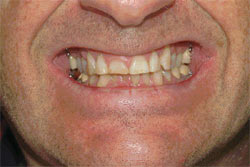 | 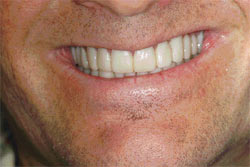 | |
| Figure 1 Pretreatment photograph showing esthetic-related problems. | Figure 2 After multiple surgical and esthetic/ restorative treatments, Esthetic Transitional Temporaries were fabricated to help develop the esthetic contours of the case. | |
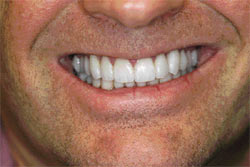 | 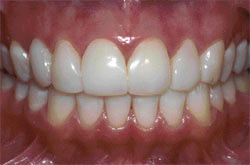 | |
| Figure 3 Posttreatment photograph exhibits predictable esthetics that were created using the Esthetic Transitional Temporaries as a prototype. | Figure 4 Pretreatment photograph shows failing composite veneers caused by moderate recurrent decay. | |
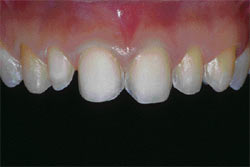 | 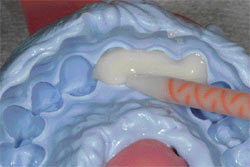 | |
| Figure 5 Conservative preparations were completed for porcelain veneers on teeth Nos. 6 through 11. | Figure 6 Bis-acryl provisional material is syringed in the template along the prepared sites. The tip is embedded as the material is expressed to avoid bubbles. | |
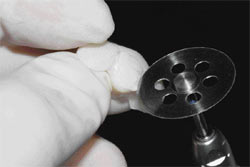 | 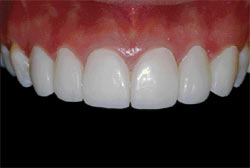 | |
| Figure 7 Using a single-sided disk from the Esthetic Transitional Temporaries Kit, the contours of the temporary restoration are refined. | Figure 8 Using an advanced bis-acryl temporary material allows for accurate fabrication of the Esthetic Transitional Temporaries. | |
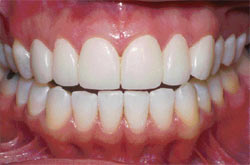 | 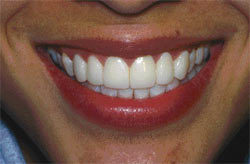 | |
| Figure 9 After proper esthetic contouring, margination, occlusal refinement, and glazing of the transitional temporaries, the patient is able to subjectively assess the esthetics of the case. | Figure 10 From this highly sculpted Esthetic Transitional Temporary restoration, the final restorations can be fabricated with confidence. | |
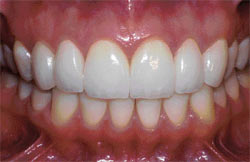 | 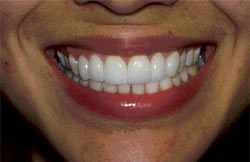 | |
| Figure 11 Duplicating the contours of the temporaries, the final porcelain veneers represent the collaboration between dentist and patient. | Figure 12 The posttreatment smile shows that esthetic success can be predictably achieved using the Esthetic Transitional Temporary restoration. | |
| About the Author | ||
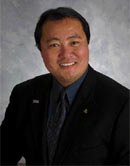 Wynn H. Okuda, DMD Wynn H. Okuda, DMD Past President and Accredited Member American Academy of Cosmetic Dentistry Private Practice Honolulu, Hawaii | ||



